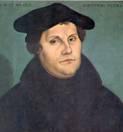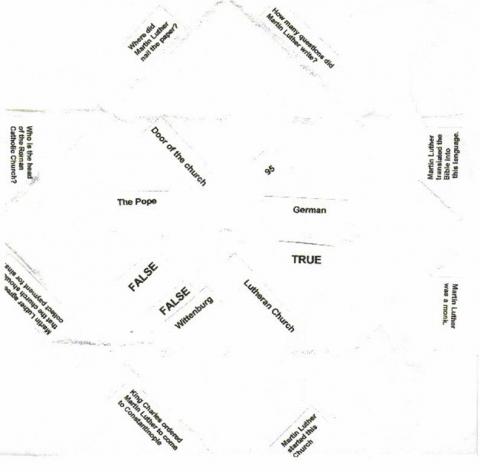Protestant Reformation: Part 1
THE PROTESTANT REFORMATION
Objectives:
- Students should know who Martin Luther was and what he did.
- Students should be able to name some of the Protestant denominations.
Possible Lesson Plan:
- Open with prayer.
- Tell the story of the Protestant Reformation up through Martin Luther.
As the years went by after the fall of Rome in the West, the church there came to be led by only one bishop, the Bishop of Rome, known also as the pope. He began to teach that he was the ruler of all the Christian church and that he alone could tell the true teachings of God. His Churches were led by Roman and were called Roman Catholic. These churches in the West began to teach that a man had to pay for any sins he committed on earth and they sold indulgences to Christians to help them pay for their sins. Soon the church was wealthy, but the people had lost touch with the real Jesus in many ways.
 Finally, a monk named Martin Luther stood up against the church officials. He opposed the wealth of the church and the selling of payment for sins. He made a public announcement of his views by nailing a paper with 95 questions on it to the door of the cathedral, or church, of Wittenburg. But, the Pope was not happy with Martin Luther. He issued a decree throwing Luther out of the Church! Martin Luther built a bonfire and burned the decree. Luther had meant only to talk the church into going back to the old teachings of the apostles, but now he had no church at all. The Pope asked King Charles of Spain to talk to Luther. King Charles ordered Luther to come to the city of Worms – funny name for a city, right? When Luther got there, King Charles ordered Martin Luther to stop talking about the things he believed. Martin Luther refused. Some of Charles’s nobles thought Luther should be burned at the stake, Charles let him go and his friends hid him from the angry nobles. So, Luther formed his own church, soon called the Lutheran church. He translated the Bible into German, the language of his people, and soon had many followers who call themselves Lutherans.
Finally, a monk named Martin Luther stood up against the church officials. He opposed the wealth of the church and the selling of payment for sins. He made a public announcement of his views by nailing a paper with 95 questions on it to the door of the cathedral, or church, of Wittenburg. But, the Pope was not happy with Martin Luther. He issued a decree throwing Luther out of the Church! Martin Luther built a bonfire and burned the decree. Luther had meant only to talk the church into going back to the old teachings of the apostles, but now he had no church at all. The Pope asked King Charles of Spain to talk to Luther. King Charles ordered Luther to come to the city of Worms – funny name for a city, right? When Luther got there, King Charles ordered Martin Luther to stop talking about the things he believed. Martin Luther refused. Some of Charles’s nobles thought Luther should be burned at the stake, Charles let him go and his friends hid him from the angry nobles. So, Luther formed his own church, soon called the Lutheran church. He translated the Bible into German, the language of his people, and soon had many followers who call themselves Lutherans.
 In other countries, other men were also protesting the teachings of the Pope. John Calvin in Switzerland formed the Reformed Church. In his church, he began to choose those teachings of the Church Fathers that he would follow and those that he would not. For example, Calvin got rid of all monks, bishops, and priests. Soon his followers, known as Calvinists, had stripped their churches of all pictures, stained glass, candles, and robes; they would not dance or play games or go to the theater. And, even though at first Calvin had been attacked by the Pope, soon the Calvinists were punishing those who disagreed with their beliefs in Switzerland.
In other countries, other men were also protesting the teachings of the Pope. John Calvin in Switzerland formed the Reformed Church. In his church, he began to choose those teachings of the Church Fathers that he would follow and those that he would not. For example, Calvin got rid of all monks, bishops, and priests. Soon his followers, known as Calvinists, had stripped their churches of all pictures, stained glass, candles, and robes; they would not dance or play games or go to the theater. And, even though at first Calvin had been attacked by the Pope, soon the Calvinists were punishing those who disagreed with their beliefs in Switzerland.
 In the land of England, the church of Rome was also losing power; but for a different reason. King Henry the Eighth wanted to get rid of his wife and marry his new girlfriend and the Pope wouldn’t let him. So, Henry declared himself head of the new Church of England and took from the bishops and monks all the lands and churches of the Pope. When people from the Church of England came to the new land of America, they became known as the Protestant Episcopal Church of America.
In the land of England, the church of Rome was also losing power; but for a different reason. King Henry the Eighth wanted to get rid of his wife and marry his new girlfriend and the Pope wouldn’t let him. So, Henry declared himself head of the new Church of England and took from the bishops and monks all the lands and churches of the Pope. When people from the Church of England came to the new land of America, they became known as the Protestant Episcopal Church of America.
Soon there were many new teachers, each forming his own church with his own choice of teachings. A teacher named John Wesley pursued a way of life of Bible study and prayer; his followers became known as Methodists. John Calvin taught that people are chosen before birth to be Christians and believed that each church should vote on what to believe and who to follow; his followers are called Presbyterians. Another group of Christians under John Smyth believed that people should only be baptized when they are grown up; these were called Baptists. Another believed that Christians should worship on Saturday, the seventh day of creation; these were called Seventh Day Adventists and were led by William Miller of New York. By now there are hundreds of groups of Christians, called denominations, in the West, each with its own set of customs and beliefs. While all these groups believe in Jesus Christ, each has chosen only parts of the teachings of the early Church and left other traditions behind.
Add Martin Luther to your timeline.
- True/False Questions:
True False
The pope is the head of the Roman Catholic The lion is the head of the Roman Catholic
Church. Church.
Martin Luther nailed his paper to the Martin Luther mailed his paper to the king.
Cathedral door.
King Charles ordered Luther to come to King Charles ordered Luther to come to
the city of Worms. Constantinople.
Martin Luther translated the Bible into Cyril and Methodius translated the Bible
German. into German.
- Try singing 3 verses of the “Ants Go Marching”:
The Church goes marching one by one…the Orthodox Church is the only one
And they all go marching down, to the church, to worship the Lord.
The Churches go marching 2 by 2…the Roman Pope makes the church two,
And Roman Catholics go marching down…
The Churches go marching 3 by 3…Martin Luther nails up his scroll…and the
Lutherans go marching down…
5. Make a Martin Luther “foursquare” finger game: Copy the pattern on the next page. Cut it out as a square. Fold it as you do a foursquare game (ask your children, they know how) and play questions and answers!
6. Close with prayer: Lord make Your Church one again as we once were one.
